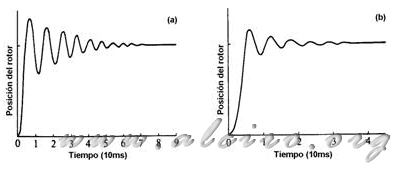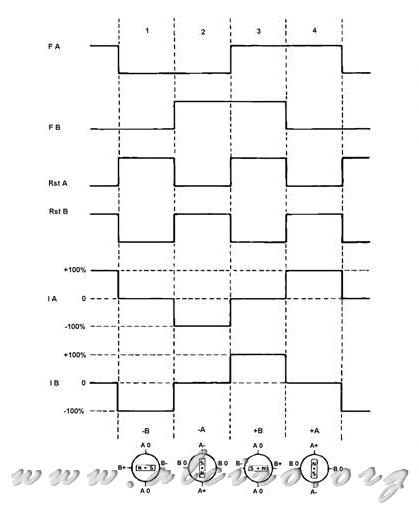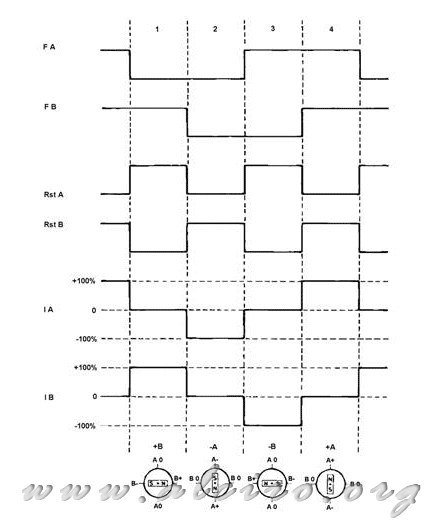4.1.2. Sequence of an active phase (wave-wave excitation)
In the sequence of wave (wave) only one phase is activated, leading to the rotor teeth are aligned with those for the stator of the active phase and the other off stage did not generate any torque. Working in full step or wave sequence implies that the same relationship of steps, the absolute position of the rotor is not equal, there is a difference between the two half-pitch, not cumulative, see figure 4.8 (a). On the other hand another consequence of this configuration is the reduction of engine torque produced about 30% over the full step sequence in a hybrid engine. It should be borne in mind that the torque is directly proportional to the intensity, and this is the resultant vector sum vector pair for each phase, which are each at an angle of 90 degrees (refer to the electrical angle power stages and for a hybrid engine). Giving a ratio of 1 to 0.7 working full step or wave respectively.

Figure 4.3 Difference in response to an impulse from the excitement of an active phase (a) and two phases acitvas (b)
In the excitement of an active phase the level and duration of the oscillations is greater than in the excitement of two active phases (see Figure 4.4). Comparing Figure 4.3 (a) and 4.3 (b), the excitation wave magnetic field is created is the active phase, making the rotor is aligned with the stator. Having a single field perpendicular to the rotor makes it more susceptible to fluctuations. While in full step excitation generates two magnetic fields that hold the rotor in the position of equilibrium with a higher holding torque, this limits the action of the load torque, providing better transient response to a step.
Table 4.2 Sequence of an active phase (wave)
| Clock | Steps | Phase A | Phase B |
| Ref | Ref | 0 | + I |
| 1 | 1 | - I | 0 |
| 2 | 2 | 0 | - I |
| 3 | 3 | + I | 0 |
| 4 | 4 | 0 | + I |
The advantage of using wave excitation lies in the low energy of this system, because at all times only one phase is active and therefore the average consumption is equivalent to one step. For a two phase motor this system provides virtually no benefit, but for other phases with a number of high energy savings and the cost of power is considerable. For example, if we have a 5-phase motor with a consumption of 2 amps per phase, full step work is a source of supply of 10 amps, while consumption wave is reduced to 2 amps.

Figure 4.4 Sequence of progress with an active phase (wave)
Figures 4.4 and 4.5 show the waveforms for forward and reverse sequence of an active phase.

Figure 4.5 Sequence back to an active phase (wave)







